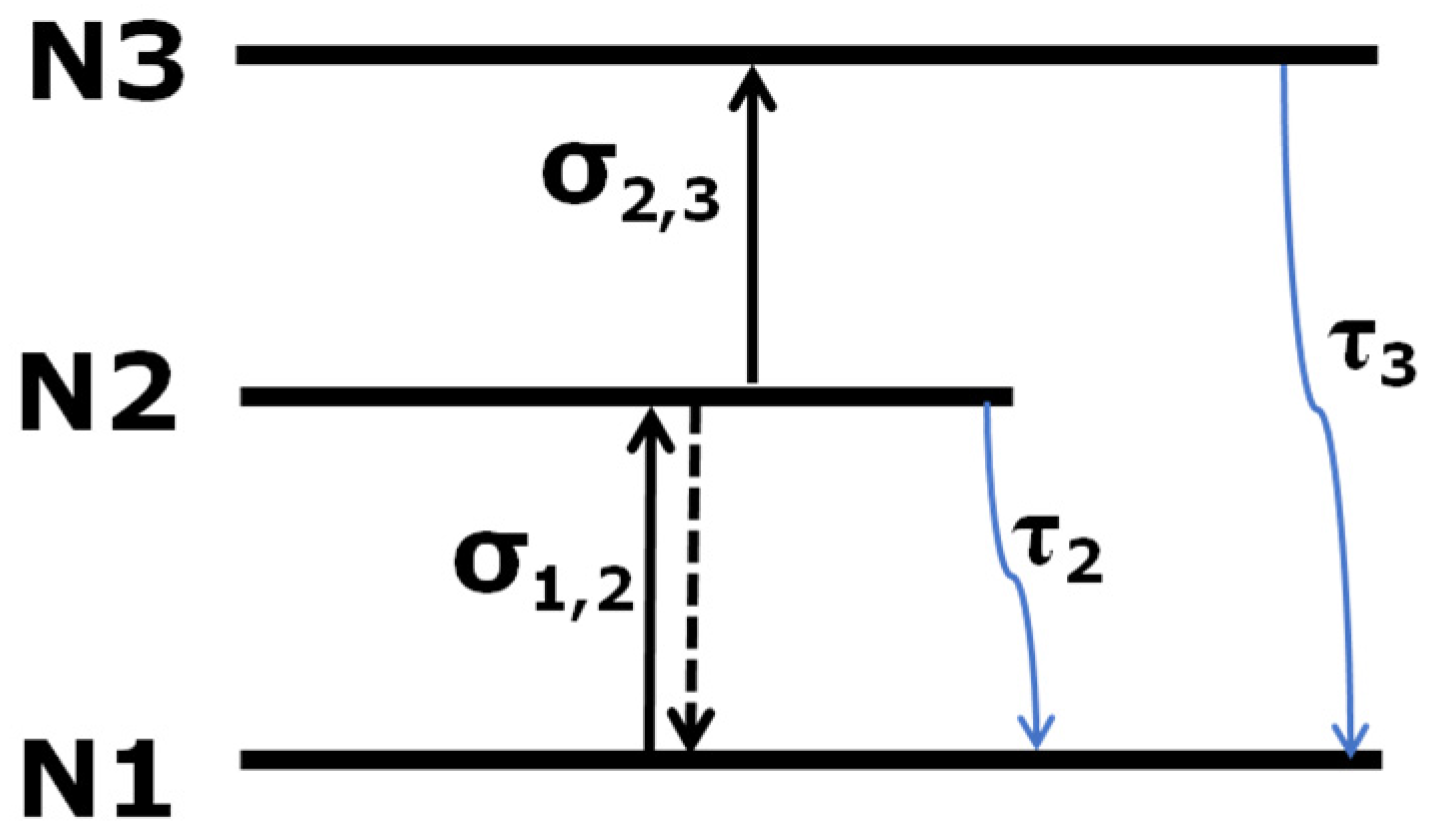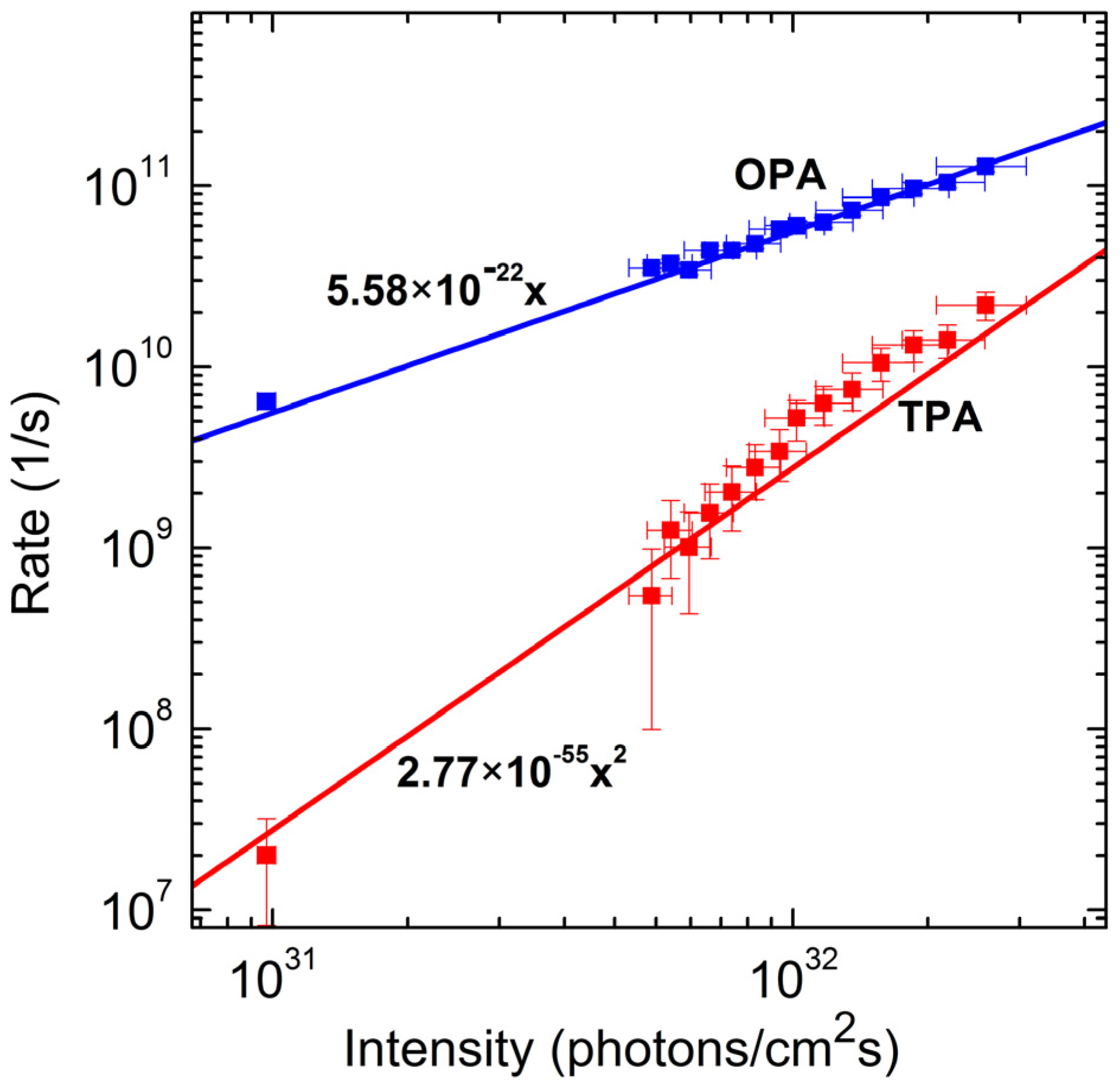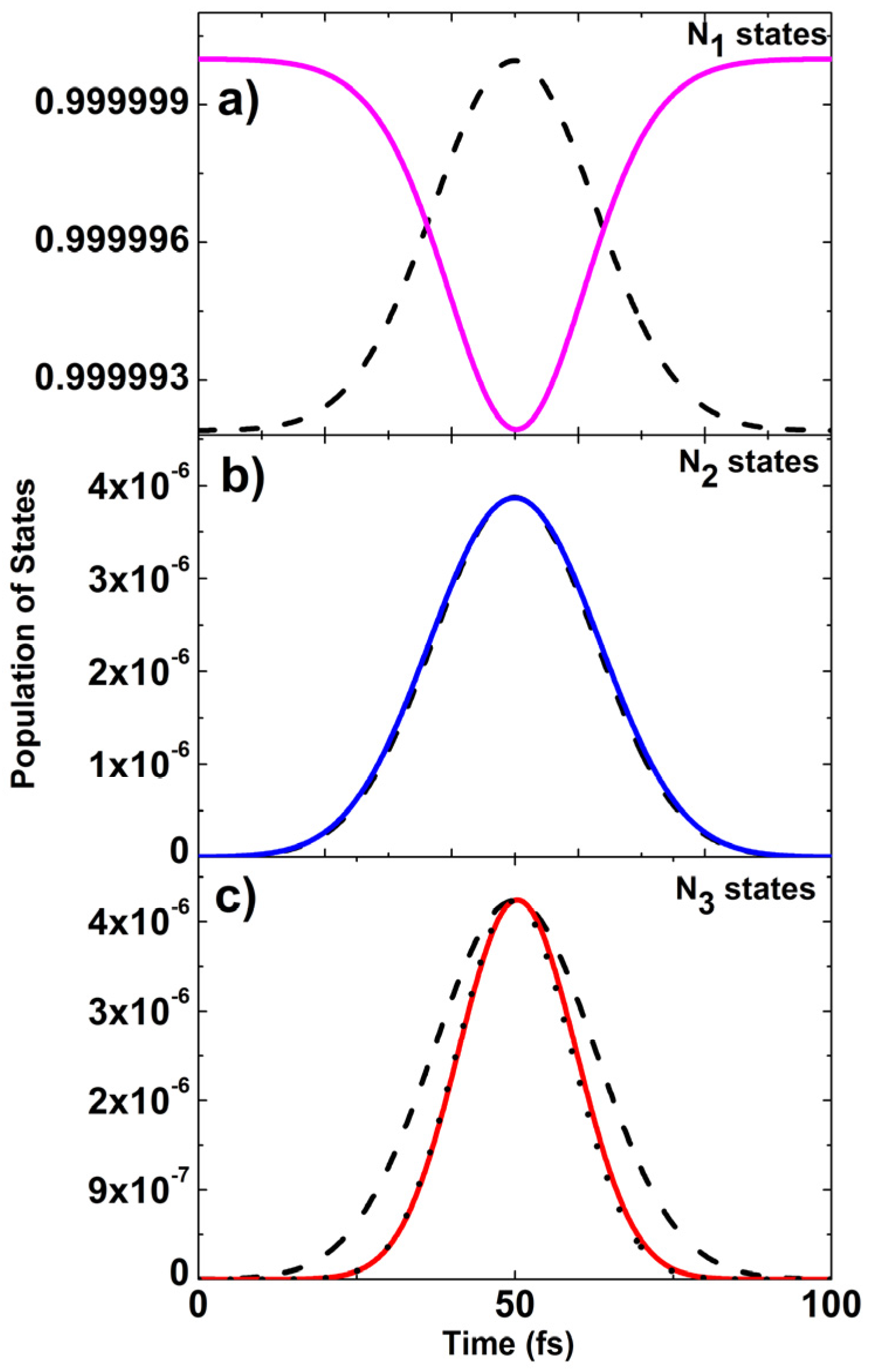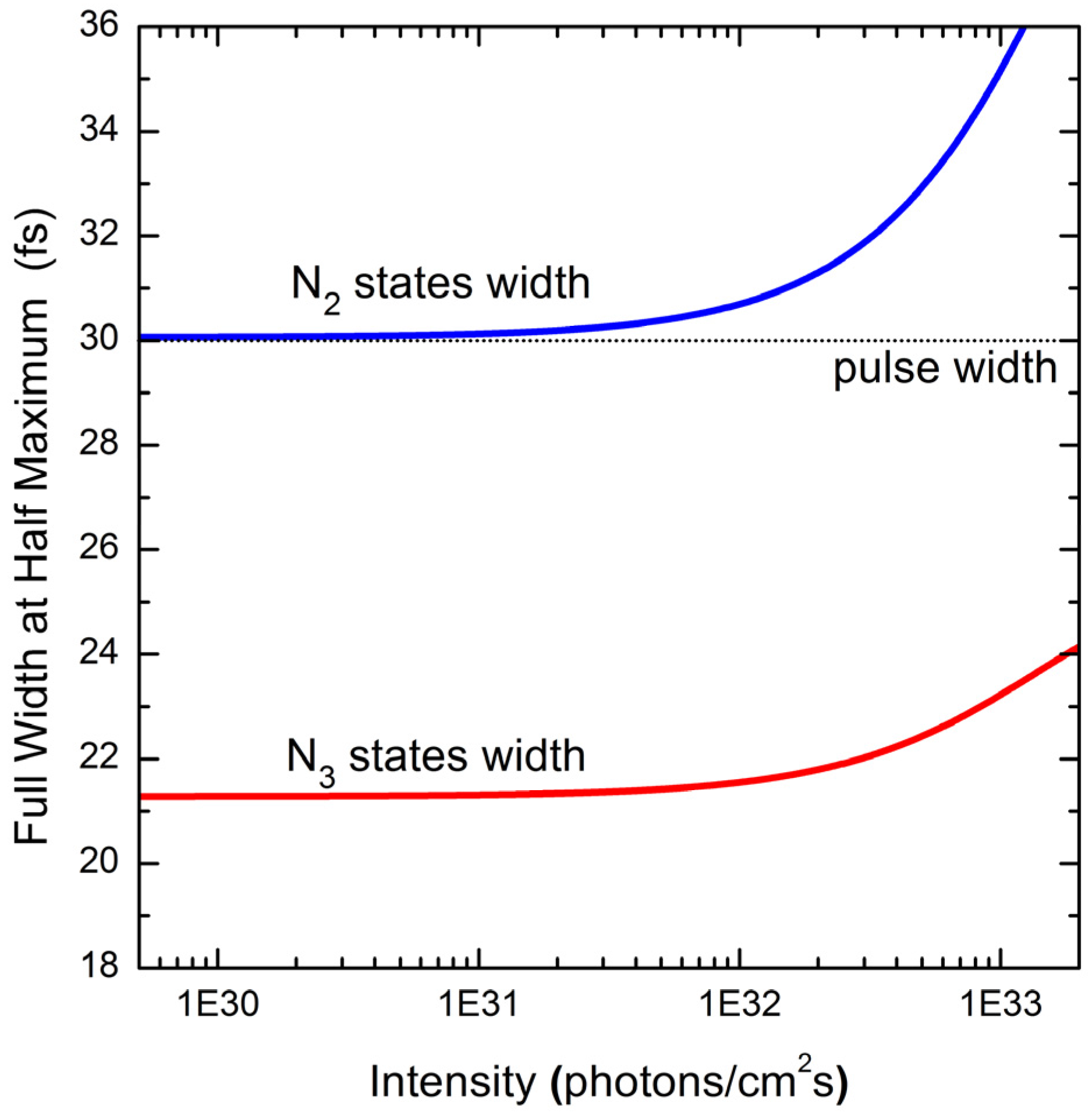State-Population Narrowing Effect in Two-Photon Absorption for Intense Hard X-ray Pulses
Abstract
:1. Introduction
2. Materials and Methods
3. Results
3.1. Details on the Computation
3.2. X-ray Rates for One- and Two-Photon Absorption
3.3. Time-Dependent Calculations for State Population
4. Discussion
Acknowledgments
Author Contributions
Conflicts of Interest
References
- Keller, U. Recent developments in compact ultrafast lasers. Nature 2003, 424, 831–838. [Google Scholar] [CrossRef] [PubMed]
- Schuster, I.; Kubanek, A.; Fuhrmanek, A.; Puppe, T.; Pinkse, P.W.H.; Murr, K.; Rempe, G. Nonlinear spectroscopy of photons bound to one atom. Nat. Phys. 2008, 4, 382–385. [Google Scholar] [CrossRef]
- Srinivasan, K.; Painter, O. Linear and nonlinear optical spectroscopy of a strongly coupled microdisk- quantum dot system. Nature 2007, 450, 862–865. [Google Scholar] [CrossRef] [PubMed]
- Hori, M.; Sótér, A.; Barna, D.; Dax, A.; Hayano, R.S.; Friedreich, S.; Juhász, B.; Pask, T.; Widmann, E.; Horváth, D.; et al. Two-photon laser spectroscopy of antiprotonic helium and the antiproton-to-electron mass ratio. Nature 2011, 475, 484–488. [Google Scholar] [CrossRef] [PubMed]
- Emma, P.; Akre, R.; Arthur, J.; Bionta, R.; Bostedt, C.; Bozek, J.; Brachmann, A.; Bucksbaum, P.; Coffee, R.; Decker, F.-J.; et al. First lasing and operation of an ångstrom-wavelength free-electron laser. Nat. Photonics 2010, 4, 641–647. [Google Scholar] [CrossRef]
- Amann, J.; Berg, W.; Blank, V.; Decker, F.-J.; Ding, Y.; Emma, P.; Feng, Y.; Frisch, J.; Fritz, D.; Hastings, J.; et al. Demonstration of self-seeding in a hard-X-ray free-electron laser. Nat. Photonics 2012, 6, 693–698. [Google Scholar] [CrossRef]
- Young, L.; Kanter, E. P.; Krässig, B.; Li, Y.; March, A.M.; Pratt, S.T.; Santra, R.; Southworth, S.H.; Rohringer, N.; DiMauro, L.F.; et al. Femtosecond electronic response of atoms to ultra-intense X-rays. Nature 2010, 466, 56–61. [Google Scholar] [CrossRef] [PubMed]
- Tamasaku, K.; Nagasono, M.; Iwayama, H.; Shigemasa, E.; Inubushi, Y.; Tanaka, T.; Tono, K.; Togashi, T.; Sato, T.; Katayama, T.; et al. Double Core-Hole Creation by Sequential Attosecond Photoionization. Phys. Rev. Lett. 2013, 111, 043001. [Google Scholar] [CrossRef] [PubMed]
- Tamasaku, K.; Shigemasa, E.; Inubushi, Y.; Katayama, T. X-ray two-photon absorption competing against single and sequential multiphoton processes. Nature 2014, 8, 313–316. [Google Scholar] [CrossRef]
- Rohringer, N.; Ryan, D.; London, R.A.; Purvis, M.; Albert, F.; Dunn, J.; Bozek, J.D.; Bostedt, C.; Graf, A.; Hill, R.; et al. Atomic inner-shell X-ray laser at 1.46 nanometres pumped by an X-ray free-electron laser. Nature 2012, 481, 488–491. [Google Scholar] [CrossRef] [PubMed]
- Beye, M.; Schreck, S.; Sorgenfrei, F.; Trabant, C.; Pontius, N.; Schüßler-Langeheine, C.; Wurth, W.; Föhlisch, A. Stimulated X-ray emission for materials science. Nature 2013, 11. [Google Scholar] [CrossRef] [PubMed]
- Vinko, S.M.; Ciricosta, O.; Cho, B.I.; Engelhorn, K.; Chung, H.-K.; Brown, C.R.D.; Burian, T.; Chalupský, J.; Falcone, R.W.; Graves, C.; et al. Creation and diagnosis of a solid-density plasma with an X-ray free-electron laser. Nature 2012, 482, 59–62. [Google Scholar] [CrossRef] [PubMed]
- Szlachetko, J.; Nachtegaal, M.; De Boni, E.; Willimann, M.; Safonova, O.; Sa, J.; Smolentsev, G.; Szlachetko, M.; Van Bokhoven, J.A.; Dousse, J.C.; et al. Establishing nonlinearity thresholds with ultraintense X-ray pulses. Sci. Rep. 2016, 6, 33292. [Google Scholar] [CrossRef] [PubMed]
- Geloni, G.; Kocharyan, V.; Saldin, E. A novel self-seeding scheme for hard X-ray FELs. J. Mod. Opt. 2011, 58, 1391–1403. [Google Scholar] [CrossRef]
- Nagler, B.; Zastrau, U.; Fäustlin, R.R.; Vinko, S.M.; Whitcher, T.; Nelson, A.J.; Sobierajski, R.; Krzywinski, J.; Chalupsky, J.; Abreu, E.; et al. Turning solid aluminium transparent by intense soft X-ray photoionization. Nat. Phys. 2009, 5, 693–696. [Google Scholar] [CrossRef]
- Yoneda, H.; Inubushi, Y.; Yabashi, M.; Katayama, T.; Ishikawa, T.; Ohashi, H.; Yumoto, H.; Yamauchi, K.; Mimura, H.; Kitamura, H. Saturable absorption of intense hard X-rays in iron. Nat. Commun. 2014, 5, 5080. [Google Scholar] [CrossRef] [PubMed]




© 2017 by the authors. Licensee MDPI, Basel, Switzerland. This article is an open access article distributed under the terms and conditions of the Creative Commons Attribution (CC BY) license (http://creativecommons.org/licenses/by/4.0/).
Share and Cite
Tyrała, K.; Wojtaszek, K.; Pajek, M.; Kayser, Y.; Milne, C.; Sá, J.; Szlachetko, J. State-Population Narrowing Effect in Two-Photon Absorption for Intense Hard X-ray Pulses. Appl. Sci. 2017, 7, 653. https://doi.org/10.3390/app7070653
Tyrała K, Wojtaszek K, Pajek M, Kayser Y, Milne C, Sá J, Szlachetko J. State-Population Narrowing Effect in Two-Photon Absorption for Intense Hard X-ray Pulses. Applied Sciences. 2017; 7(7):653. https://doi.org/10.3390/app7070653
Chicago/Turabian StyleTyrała, Krzysztof, Klaudia Wojtaszek, Marek Pajek, Yves Kayser, Christopher Milne, Jacinto Sá, and Jakub Szlachetko. 2017. "State-Population Narrowing Effect in Two-Photon Absorption for Intense Hard X-ray Pulses" Applied Sciences 7, no. 7: 653. https://doi.org/10.3390/app7070653






